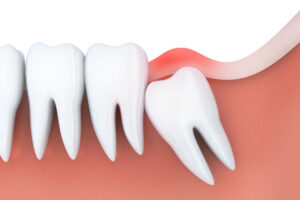Wisdom Tooth
What are wisdom teeth?
Wisdom tooth is another name for any one of four third molars found in the permanent dentition. These teeth are the last or most posterior teeth in the dental arch. Although most people have wisdom teeth it is possible for some or all of the third molars to never develop. It is also possible for a person to have more than four wisdom teeth. In many individuals, the wisdom teeth aren’t visible because they have become impacted (not normally erupted through the gums) under the gingival tissue.
How do I know if I have wisdom teeth?
You know if you have wisdom teeth by examining your mouth and finding three permanent molars in each dental quadrant. However, if the tooth is impacted under the tissue, presence of the tooth needs to be verified by a radiography. A panoramic radiography is usually the preferred X-ray to help assess the angle of eruption and state of development of the tooth. Most wisdom teeth can be visualized erupting through the gingiva in early adulthood, between the ages of 16 to 23. Sometimes, a person will feel the effects of the wisdom teeth before they are able to visualize them in their mouth. Erupting wisdom teeth will usually produce a feeling of pressure or dull throbbing in the back of the jaws. Your general dentist will often be able to inform you of the condition of these erupting teeth.
How is wisdom tooth extraction performed?
Once it has been determined that a wisdom tooth is problematic, extraction by an oral surgeon or qualified general dentist is usually indicated. Local anesthesia is administered to ensure the tooth can be pulled out without any major discomfort. Many people will choose conscious sedation (being put into a sleepy state where pain signals are blocked) so they have little or no memory of having the wisdom teeth extracted. A minor surgery is then performed where the tissue and bone around the wisdom tooth are removed so that the tooth can be cleanly extracted from the socket. Several stitches may be needed to close the surgical site and promote healing of the overlying tissue. These stitches may either be dissolvable stitches that come out on their own after three to five days or stitches that need to be removed by the surgeon after a certain period of time.
After Wisdom Teeth Extraction
Pain and discomfort after a tooth replacement tends to last for two to three days. During this time, you should be taking any pain medication that might have been prescribed in addition to any antibiotics that were recommended. During recovery it is also imperative to avoid smoking and sucking on items such as straws. Doing so could dislodge the clot that has formed over the extracted tooth’s area. You should rinse the mouth out with salt water gently after your first day of recovery and after you have taken the gauze out. You should not disrupt the stitches by talking too much, eating hard foods, or rubbing the area with your tongue (though it may be tempting).

